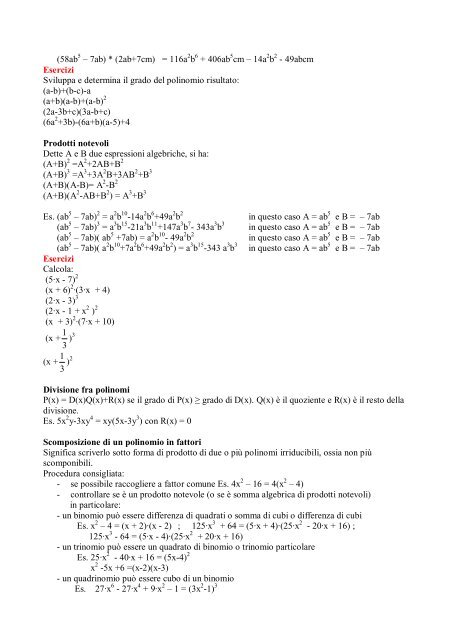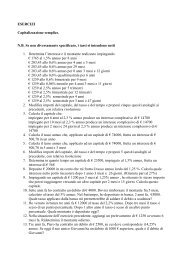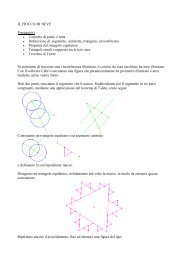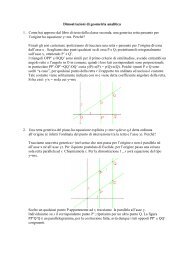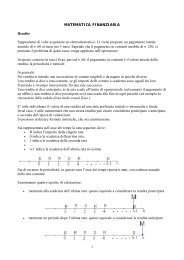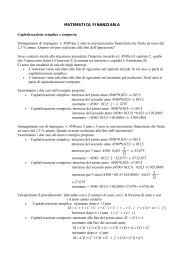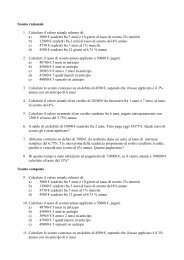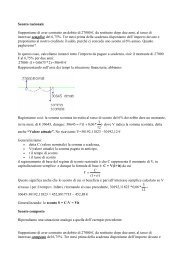MODULO DI MATEMATICA di accesso al triennio ... - Itcgruffini.Eu
MODULO DI MATEMATICA di accesso al triennio ... - Itcgruffini.Eu
MODULO DI MATEMATICA di accesso al triennio ... - Itcgruffini.Eu
You also want an ePaper? Increase the reach of your titles
YUMPU automatically turns print PDFs into web optimized ePapers that Google loves.
(58ab 5 – 7ab) * (2ab+7cm) = 116a 2 b 6 + 406ab 5 cm – 14a 2 b 2 - 49abcm<br />
Esercizi<br />
Sviluppa e determina il grado del polinomio risultato:<br />
(a-b)+(b-c)-a<br />
(a+b)(a-b)+(a-b) 2<br />
(2a-3b+c)(3a-b+c)<br />
(6a 2 +3b)-(6a+b)(a-5)+4<br />
Prodotti notevoli<br />
Dette A e B due espressioni <strong>al</strong>gebriche, si ha:<br />
(A+B) 2 =A 2 +2AB+B 2<br />
(A+B) 3 =A 3 +3A 2 B+3AB 2 +B 3<br />
(A+B)(A-B)= A 2 -B 2<br />
(A+B)(A 2 -AB+B 2 ) = A 3 +B 3<br />
Es. (ab 5 – 7ab) 2 = a 2 b 10 -14a 2 b 6 +49a 2 b 2<br />
in questo caso A = ab 5 e B = – 7ab<br />
(ab 5 – 7ab) 3 = a 3 b 15 -21a 3 b 11 +147a 3 b 7 - 343a 3 b 3 in questo caso A = ab 5 e B = – 7ab<br />
(ab 5 – 7ab)( ab 5 +7ab) = a 2 b 10 - 49a 2 b 2<br />
in questo caso A = ab 5 e B = – 7ab<br />
(ab 5 – 7ab)( a 2 b 10 +7a 2 b 6 +49a 2 b 2 ) = a 3 b 15 -343 a 3 b 3 in questo caso A = ab 5 e B = – 7ab<br />
Esercizi<br />
C<strong>al</strong>cola:<br />
(5·x - 7) 2<br />
(x + 6) 2 ·(3·x + 4)<br />
(2·x - 3) 3<br />
(2·x - 1 + x 2 ) 2<br />
(x + 3) 2 ·(7·x + 10)<br />
(x + 3<br />
1 ) 3<br />
1 2<br />
(x + )<br />
3<br />
Divisione fra polinomi<br />
P(x) = D(x)Q(x)+R(x) se il grado <strong>di</strong> P(x) grado <strong>di</strong> D(x). Q(x) è il quoziente e R(x) è il resto della<br />
<strong>di</strong>visione.<br />
Es. 5x 2 y-3xy 4 = xy(5x-3y 3 ) con R(x) = 0<br />
Scomposizione <strong>di</strong> un polinomio in fattori<br />
Significa scriverlo sotto forma <strong>di</strong> prodotto <strong>di</strong> due o più polinomi irriducibili, ossia non più<br />
scomponibili.<br />
Procedura consigliata:<br />
- se possibile raccogliere a fattor comune Es. 4x 2 – 16 = 4(x 2 – 4)<br />
- controllare se è un prodotto notevole (o se è somma <strong>al</strong>gebrica <strong>di</strong> prodotti notevoli)<br />
in particolare:<br />
- un binomio può essere <strong>di</strong>fferenza <strong>di</strong> quadrati o somma <strong>di</strong> cubi o <strong>di</strong>fferenza <strong>di</strong> cubi<br />
Es. x 2 – 4 = (x + 2)·(x - 2) ; 125·x 3 + 64 = (5·x + 4)·(25·x 2 - 20·x + 16) ;<br />
125·x 3 - 64 = (5·x - 4)·(25·x 2 + 20·x + 16)<br />
- un trinomio può essere un quadrato <strong>di</strong> binomio o trinomio particolare<br />
Es. 25·x 2 - 40·x + 16 = (5x-4) 2<br />
x 2 -5x +6 =(x-2)(x-3)<br />
- un quadrinomio può essere cubo <strong>di</strong> un binomio<br />
Es. 27·x 6 - 27·x 4 + 9·x 2 – 1 = (3x 2 -1) 3


